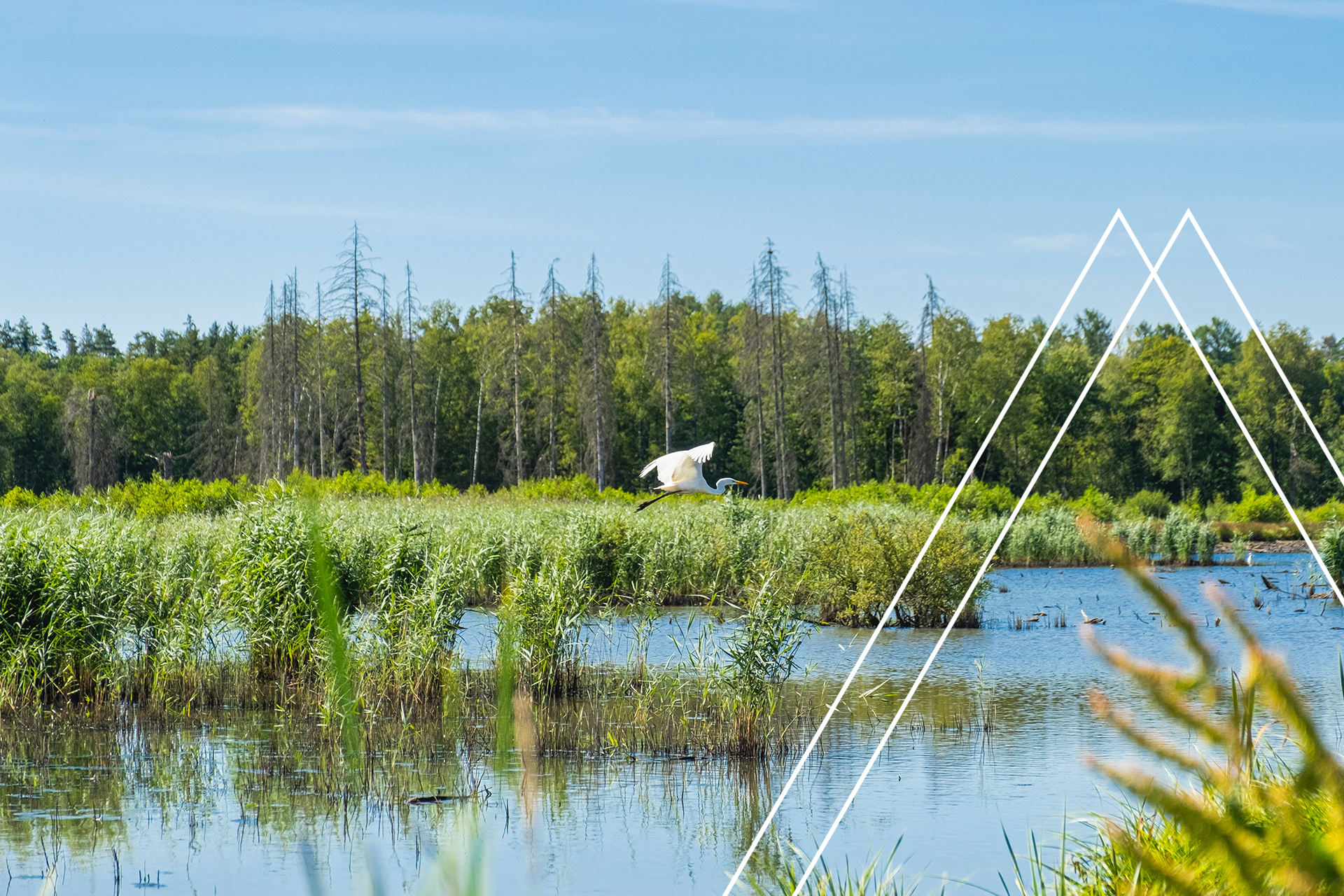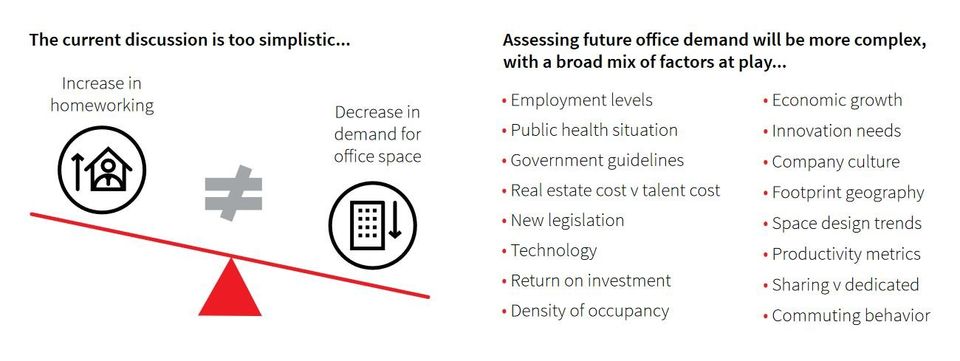The future of workspace: How will the office real estate sector adapt?
The ongoing COVID-19 pandemic has impacted all aspects of people’s way of living and working. One of the most significant changes has been the shift to employees working from home. Although lockdown restrictions are now easing in some places, the pandemic spells uncertain times not only for businesses and their employees, but also for the real estate industry.
A new age of remote working
Traditional office life as we know it is gone. COVID-19 has significantly altered our work routines, fast-forwarding the future of work which, up until now, has taken years to unfold. In a world where physical distancing has become imperative, the way people interact with spaces they occupy has transformed as a result – and these changes are here to stay.
According to the ifo Institute, three-quarters of German companies made working from home arrangements with staff to better deal with the crisis. Their research further shows that 54% of companies see working from home arrangements not just as temporary, but rather a long-term solution. Many have noticed results that have been better than imagined, acknowledging the swiftness with which different forms of digital collaboration, such as videoconferencing, were adopted.
Several companies have already made announcements of permanent work from home policies. Amongst one of the first was social media giant Twitter who announced on their blog in mid-May 2020:
“If our employees are in a role and situation that enables them to work from home and they want to continue to do so forever, we will make that happen. If not, our offices will be their warm and welcoming selves, with some additional precautions, when we feel it’s safe to return.”
More companies have since followed suit, embracing a remote work first model. Siemens is the first large German company that has announced a permanent remote work arrangement, planning to let more than half of Siemens’ total workforce do mobile work for an average of two to three days a week. These changes, which are intended to shift the focus from time spent in the office to work outcomes, will apply to more than 140,000 employees based at 125 locations in 43 countries.
You can find out about how EnviroSustain’s company values helped us navigate COVID in our recent blog post.
The rise of job satisfaction in times of crisis
The increase in incorporating permanent remote work models in corporate policy is reflective of the positive results that working from home has yielded for a majority of companies and their employees. At the end of 2019, a quarter of the German workforce was eligible for remote or mobile work, while Europe-wide, only 14% of employees engaged in remote work. Following the onset of the pandemic, this number has increased considerably over the last months – as has job satisfaction and happiness.
75% of employees said they have been able to maintain or improve productivity, according to a large-scale study by BCG. In Germany, the majority of staff report a better work-life balance, with 59% saying they are more productive in their current work from home environment. Besides increased work satisfaction, employees’ stress levels, another important indicator for health and well-being, have decreased by 29%.
The environmental movement has also pointed towards the emissions saving potential of increased levels in remote work. In a study commissioned by Greenpeace, the IZT Institute for Future Studies and Technology Assessment arrived at the conclusion that the expansion of remote work schemes represents a low investment possibility to limit global greenhouse gas emissions. In a scenario assuming a share of 40% of teleworkers and the possibility of working from home for two days a week, the annual savings potential amounts to 5.4 million tonnes CO2equivalent. This corresponds to 18% of emissions from commuting and 4% of total passenger transport emissions.
A large majority of the global workforce believes companies should continue adapting remote work models. Global Workplace Analytics, a leading research and consulting firm for the future of work, has found that 77% of employees say they want to continue working from home post-COVID.
Remote work as a double-edged sword
However, the question remains whether the positive short-term results in job satisfaction are indicative of a long-term viability of working from home. Despite the clear evidence demonstrating that remote work has brought key successes in employee sentiment, productivity, and work-life-balance, insights into how employees are coping in the current situation also reveal challenges.
For instance, reduced levels of social as well as professional exchange have been widely voiced as a concern. This has raised questions of how team cohesion and innovation will be fostered in a more decentralised work force. Some even assume that more widely adopted remote work schemes could potentially erode company cultures and identities. The on-boarding process for new employees could also suffer under remote conditions.
Especially young professionals could be negatively affected in their formative years in the working world. Spending little time in the physical office could hinder their professional development in terms of acquiring new skills, forming values and building relationships. Interestingly, studies carried out after the onset of the worldwide pandemic suggest that despite general preferences towards flexible work, especially tech-savvy young professionals experienced difficulties working from home.
The expansion of remote work in recent months has also led to concerns over employee health and well-being. While an array of studies suggests job satisfaction and productivity have increased for many employees, the complexity of emerging health and wellness challenges should not be overlooked.
The change of work environment from the physical office space to the home office has taken a toll on employees’ physical and mental health, research suggests. According to the architecture practice Assael Architecture, almost two-thirds of people working remotely during the lockdown experienced negative mental health impacts from staying indoors for long periods of time. Due to reduced social interaction and a blurring of lines between work and personal life, isolation and burn-out have been two major causes for concern.
In many cases, employees’ home environments were not adequately designed for remote work. Lack of space, lack of natural light as well as noise pollution were reported as the biggest concerns, negatively affecting work productivity. Further, decreased movement and increased sedentary behaviour resulting from working at home poses serious risk of health problems, including heart diseases, obesity and musculoskeletal disorders. This shows that whereas companies are in a position to constantly adapt to changing workplace design needs and office ergonomics, employing this kind of flexibility and adaptability remains difficult in home environments.
As the trend towards working remotely is gaining more momentum, both advantages and challenges have been revealed. What does this mean for the future of work and office space? Changing work patterns are also having serious knock-on effects on the demand for office space. Will this put the real estate office sector in turmoil?
The end of office centric working?
It is clear that with COVID-19 as a game changer, current developments in the world of work are having repercussions on real estate markets. While housing markets are generally more resilient, given the undiminished need for shelter, office property markets are undergoing considerable change. The increase in remote work comes along with several companies announcing plans to move or even decrease their current office spaces. Besides a short-term fall in prices due to the economic crisis, it is likely we will see existing trends and structural changes shaping the office sector accelerate.
While it is hard to make bold predictions in the current situation of uncertainty, an array of future scenarios is being developed for the office landscape. These range from scenarios predicting almost no change, to scenarios envisioning a long-term downturn in office space demand, while some scenarios see an increase in demand for office space. For instance, real estate services provider JLL envisions three possible scenarios for post-COVID Germany:
Figure 1: Own overview of findings as presented in the research report “After Corona: Scenarios for the future significance of office use” (JLL, June 2020).
All scenarios see users, investors and developers take more caution. According to JLL, the Back to Business scenario, in which the overall demand for office space decreases by 10% post-COVID, is the one most likely to occur. This would initially lead to increasing vacancy rates, also due to handing back of space. In the letting market, take-up is predicted to remain at a lower level for an elongated period of time, with newly concluded contracts seeing smaller but high-quality volumes of space rented. Companies are set to decrease their plans for expansion. Providers of flexible office space will benefit from growing corporate requirements for more flexibility.
Further JLL predictions for the office space investment market see increasing financing costs lead to limited transaction activity. Acquisitions will be investigated more thoroughly and properties will have to meet high requirements for flexibility, alternative use potential, location as well as digital infrastructure. Themes that have been prevalent in the past years will likely accelerate, including diversification, business resiliency as well as ESG investing.
Other leading voices in the real estate realm arrive at similar predictions. A CBRE Research Client surveyshows that despite a likely rise in flexible work patterns, the physical office remains important for global real estate executives. Even in the midst of the pandemic, 70% are setting long-term real estate strategies, with few considering leaving high-density urban cores, more so exploring suburban satellite strategies.
The Savills Global Sentiment Survey mirrors these predictions. While only a small fraction of respondents expect remote work to greatly increase, 84% of respondents believe remote work will somewhat increase. This reinforces the widely held assumption that in the future organisation of work, office space will continue to play a vital role in corporate culture and communication.
In contrast to JLL’s assumption of no significant change in location preferences under the Back to Normal scenario, Savills expects a shift towards diverse location strategies. Similarly, Cushman & Wakefield speaks of a total workplace ecosystem, which will see the development of “an ecosystem of a variety of locations and experiences to support convenience, functionality and wellbeing”.
Interestingly, Cushman & Wakefield forecasts real estate footprint sizes to remain steady, as the increase in flexible work and resulting decrease in people present in the office is offset by space requirements to adhere to social distancing measures. Savills also supports this view, predicting reduced office size requirements for companies that successfully take up remote and flexible work practices. However, they do not assume this will be offset by increasing office space requirements due to social distancing behaviour, but will rather impact occupier demand in terms of a slight fall. With a more optimistic view on office investment activity, half of Savills survey respondents expect no to see no changes after the pandemic:
Figure 2: The impact on office demand after the pandemic has passed. Source: “The impact of Covid-19 on real estate” (Savills, 2020).
While it is difficult to arrive at reliable predictions at this point in time, it should be noted that the future of office demand is linked to a range of factors which will need to be monitored over the coming months. Besides remote work, parameters such as the public health situation, economic growth, governmental guidelines, employment levels, technology and user density need to be taken into consideration:
Figure 3: The future of the workplace is dependent on a wide range of factors. Source: The Future of Global Office Demand (JLL, 2020).
Nonetheless, it seems clear that trends in workplace transformation are likely to continue to move towards the physical office as a shared collaborative space. This shift will likely be driven by the forming of a more hybrid workforce which works in office as well as remotely.
The death of the physical office space as such seems unlikely, especially as the physical office is important for driving company brand and culture and attracting talent. However, it is probable that the crisis will elevate the unique role of the office as a space for augmented employee interaction and communication.
Healthy work spaces are more important than ever
The remote work trend isn’t the only one shaping the future of the office. Heightened considerations for office health and safety are becoming standard. It is clear the COVID-19 pandemic is going to significantly impact how we design office spaces, elevating the social pillar in ESG.
Occupiers may increasingly look at green building certification systems, which have long demonstrated leadership in recognising the impact of building office design on the health, well-being and productivity of employees. In fact, green building certification standards have adopted health and well-being as a central component in their certification processes.
Health and well-being in the workplace, already a hot topic before the crisis, will only increase in importance. In recognition of this, we at EnviroSustain are looking forward to the launch of our new service area EmotionS at the end of this year, forming one of our five ESG goals for 2020, as detailed in our 2019 ESG Report:
At the core of EmotionS lies the conviction that physical spaces have a significant influence on how we feel, work and interact with others. Designing spaces with people’s wellbeing in mind creates optimal conditions for people to thrive and maximise their health and productivity. By investing in spaces that put the health of the individual first and prioritising people’s needs for comfort, communication and social cohesion, we help build the strong human foundation that is required to forge a sustainable future, especially in such challenging times as we are currently experiencing.
Without doubt, the COVID-19 pandemic has impacted and will continue to change the way we work for the foreseeable future. What this means for real estate investors, design firms, businesses and employees in the long-term is yet to be seen. It is clear, however, that as businesses re-occupy their work spaces, new trends are going to emerge as part of a new normal.
As the world enters a new era of work, office space will likely emerge as a hub for heightened communication and innovation. Operational resilience will be key to allow companies the flexibility to devise new strategies for the new world that we are living in.
Thank you for reading this post! We hope you found it to be informative. Make sure you don’t miss out on our future content: follow our company page on LinkedIn.









Head Office, Berlin,
Neue Grünstraße 17 | 18 Hof 1 | TRH 3
10179 Berlin
© ES EnviroSustain GmbH 2021







